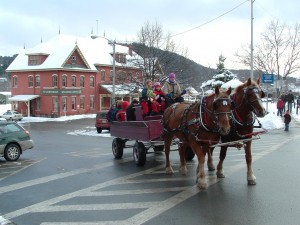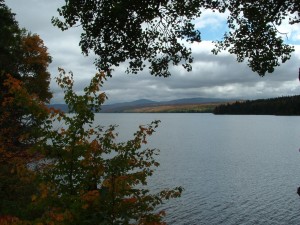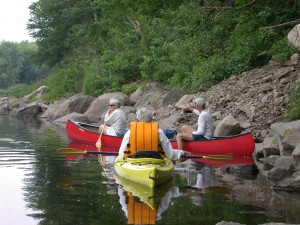Itineraries
Historic Sites
St. Johnsbury has long been the cultural and commercial center for a forested and mountainous corner of Vermont known as the Northeast Kingdom, a distinctive name its residents use with pride. It stands at the heart of the Passumpsic River basin, one of the largest tributary watersheds of the upper Connecticut River. The largest of many hill towns in the region, “St. J” is home to one of the finest collections of Victorian-era architecture in northern New England. The Fairbanks family, whose legacy lives on in the museum, library, and school they founded, shaped much of the town’s industrial and social history and the architecture of the vibrant downtown they helped to build.
 St. Johnsbury is the Waypoint community for an area that includes the Vermont towns of Lyndon, Danville, Barnet, Waterford and other towns in the Passumpsic River basin, as well as bordering Littleton, NH. St. Johnsbury’s Waypoint Interpretive Center has found a fitting and handsome home in the 1883 Victorian railroad station on Railroad Street in the downtown.
St. Johnsbury is the Waypoint community for an area that includes the Vermont towns of Lyndon, Danville, Barnet, Waterford and other towns in the Passumpsic River basin, as well as bordering Littleton, NH. St. Johnsbury’s Waypoint Interpretive Center has found a fitting and handsome home in the 1883 Victorian railroad station on Railroad Street in the downtown.
The designated Byway routes in the St. Johnsbury area in Vermont are Routes 2 from St. J to Lunenburg, Route 5 from St. J to points south, and Route 18 from Waterford to Littleton. In New Hampshire, the designated Byway route is Route 135. Also designated is the section of Interstate 93 that links St. Johnsbury with Littleton, crossing the Connecticut River at a dramatic view just below Moore Dam.
Nature and Scenery
St. Johnsbury’s first settlement was established in 1787 on an elevated plateau of glacial origins overlooking the confluence of the Passumpsic, the Sleepers, and the Moose Rivers. The Passumpsic continues south through a picturesque valley to its confluence with the Connecticut River at Barnet. There you can see the remains of ancient flood plain forests on the so-called Nine Islands, whose number actually varies depending on the water level.
The Northeast Kingdom also includes the watershed of the Nulhegan River, which has been protected by the State of Vermont and the Silvio O. Conte National Fish and Wildlife Refuge. The Conte Refuge embraces habitat in the four states of the Connecticut River watershed. Its web site and education centers offer a fascinating glimpse into the life of the river.
The Fairbanks Museum and Planetarium is northern New England’s premier museum of natural history. Established in 1889, it still follows its founder’s vision to “stimulate understanding of the natural and human environments and their interrelationships, through programs, exhibits, services, and collections.” With more than 18,000 square feet of exhibits – and a planetarium – the Fairbanks displays more than 150,000 objects from nature and cultures around the world. Look for comprehensive collections of northern New England’s birds and wildlife, a spectacular array of large mounted mammals, and a remarkable photographic collection of snowflakes made in the 19th century by “Snowflake” Bentley, Vermont’s singular student of snow.
History and Culture
 In the 19th century a single family emerged to dominate both the industrial and cultural center of the town, the fortunes of the town rose with the family. The Fairbanks family developed the first commercial platform scale, which could weigh the bulky locally produced crops of hemp using a system of levers. At first the scale was just an addition to their product line of farm implements, but the scale business quickly grew to employ a thousand workers in various shops, forges and foundries. When the railroads arrived in the 1850s, the entrepreneurial family manufactured locomotives.
In the 19th century a single family emerged to dominate both the industrial and cultural center of the town, the fortunes of the town rose with the family. The Fairbanks family developed the first commercial platform scale, which could weigh the bulky locally produced crops of hemp using a system of levers. At first the scale was just an addition to their product line of farm implements, but the scale business quickly grew to employ a thousand workers in various shops, forges and foundries. When the railroads arrived in the 1850s, the entrepreneurial family manufactured locomotives.
The railroads transformed a meadow below Main Street into a thriving commercial district of banks, shops and hotels on Railroad Street. Dozens of passenger trains passed through each day on their way to Montreal and Boston and points afar. A vibrant French Canadian community of mill workers grew on the slope between the upper and lower part of town. The imprint of all this is reflected in four historic districts in St. Johnsbury that retain the flavor of the times in which they were built.
 The Fairbanks Museum, a gift of the Fairbanks family to the community, is now listed on the National Register of Historic Places. Designed by local architect Lambert Packard in the Richardson Romanesque style, the building is characterized by massive stone work, towers, eyebrow windows, gargoyles and other stone carvings, and arches. The Museum is considered an extremely rare and virtually unaltered survivor from the nineteenth century. Interior as well as exterior features survive, including most of the built-in 1890’s display cases and original collection.
The Fairbanks Museum, a gift of the Fairbanks family to the community, is now listed on the National Register of Historic Places. Designed by local architect Lambert Packard in the Richardson Romanesque style, the building is characterized by massive stone work, towers, eyebrow windows, gargoyles and other stone carvings, and arches. The Museum is considered an extremely rare and virtually unaltered survivor from the nineteenth century. Interior as well as exterior features survive, including most of the built-in 1890’s display cases and original collection.
The cultural heart of St. Johnsbury embraces several institutions created by the Fairbanks family. Just down the street from the Fairbanks Museum and Planetarium is the St. Johnsbury Athenaeum, a distinctive public library and art gallery declared a National Historic Landmark. The Fairbanks family gave the Athenaeum to the town in 1871. Its art collection now contains a number of Hudson River School paintings. Dominating the gallery is the magnificent canvas, about ten feet by fifteen feet, of the Domes of the Yosemite, by Albert Bierstadt. The artist visited St. Johnsbury often until his death in 1902, touching up the canvas from time to time.
Just down the same street a bit further is the St. Johnsbury Academy, serving both boarding students and local high school students. Its campus includes the High Victorian Gothic-style Brantview, formerly the Fairbanks home at the south end of Main Street. Six churches and the St. Johnsbury House Hotel complete the Main Street collection.
Catamount Arts brings events to the area throughout the year; as does the Arts Alliance of Northern New Hampshire.
Recreation
In this region, the Connecticut River is impounded in two reservoirs, which provide excellent opportunities for boating and fishing, including ice fishing. Moore Reservoir, at 3,500 acres, is New Hampshire’s fourth largest lake, and its largest undeveloped lake. The state line is inundated here, and much of Moore Reservoir is actually Vermont waters. PG&E National Energy Group maintains many access ramps and picnic areas around the reservoir.
Below Moore Dam, the Connecticut River immediately enters Comerford Reservoir, another eight miles of excellent boating and fine fishing for both trout and bass, all with memorable views of the Presidential Range of the White Mountains to the east. Below Comerford, the Connecticut River becomes narrow, the province of canoeists and kayakers. The Connecticut River Joint Commissions provides a series of maps which identify river access and describe other important aspects of boating and recreation on the river. They include: Moore Reservoir and Lower Fifteen Mile Falls.
Railroads
St. Johnsbury was the junction of several railroad lines – the St. Johnsbury and Lake Champlain Railroad (running east-west) and the Connecticut and Passumpsic Rivers Railroad (north-south.) The enormous and many-gabled Canadian Pacific depot, built as a union station in the last quarter of the 19th century, presently houses the Rural Community Transportation system as well as several businesses. The rail line south of St. Johnsbury includes a number of historic steel truss bridges over the Passumpsic River.